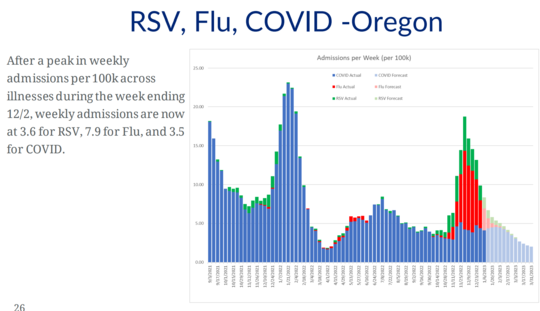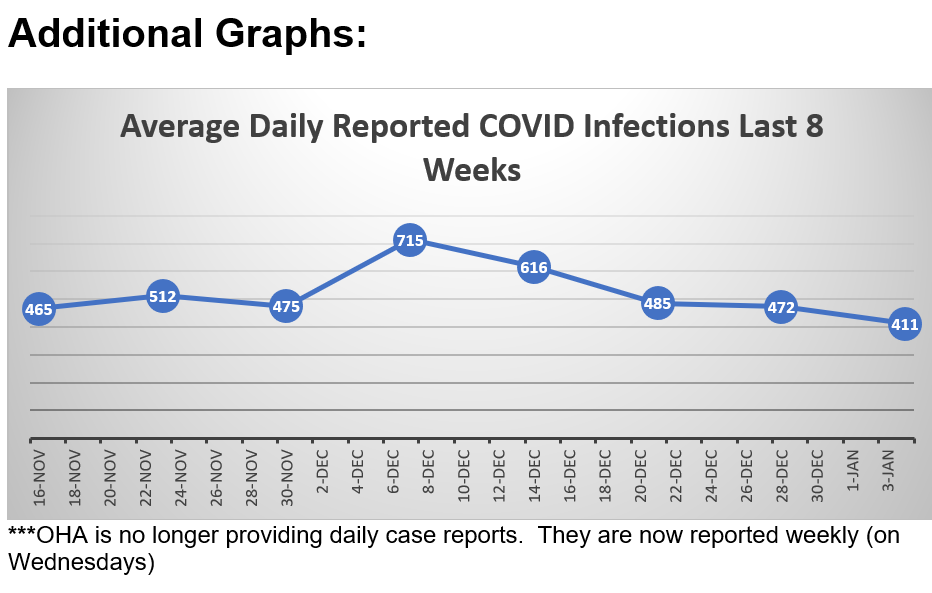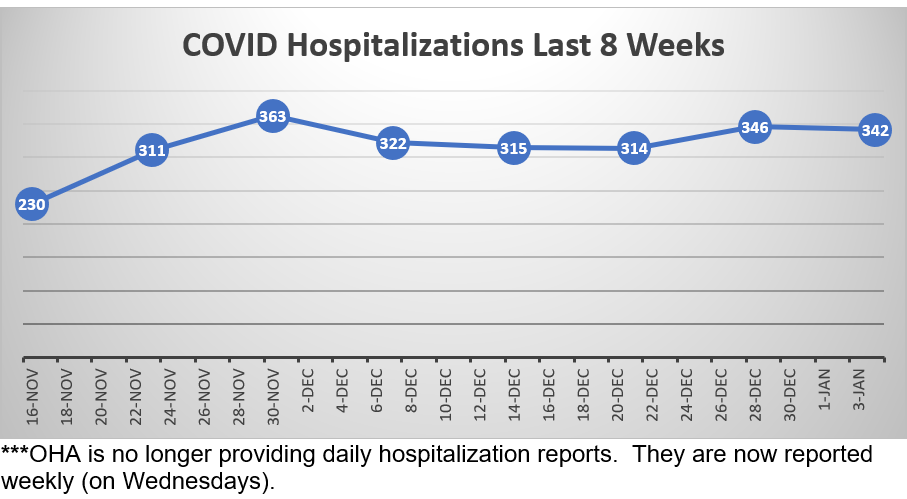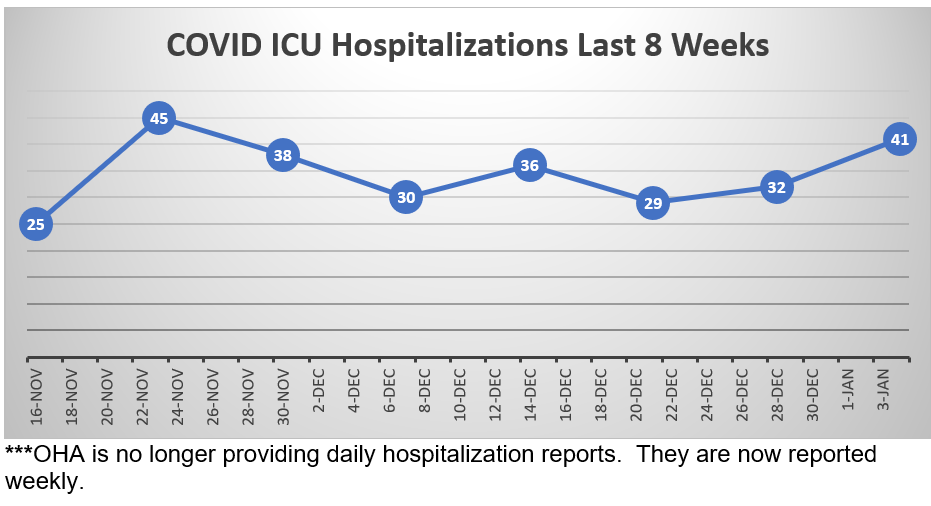|
January 8, 2023
Dear Neighbors and Friends,
I hope that you and your loved ones are doing well, staying healthy, and looking out for your neighbors and friends during this past week. I hope you had an excellent New Year’s holiday and are still sticking to your resolutions a week later!
Tomorrow marks the beginning of Oregon’s 2023 legislative session. In this week’s newsletter, you’ll find a rundown of what’s on the agenda for our big ceremonial gathering tomorrow, information on how to access all the bills that have already been introduced, and a sense of what will be going on behind the scenes this week in preparation for the first meetings of our legislative committees next week.
On the COVID front, here in Oregon we’re continuing to see gradual declines in cases and hospitalizations, though sadly the previous increases are now resulting in an increase in COVID deaths, particularly among the elderly and the unboosted. As you’ll see below, Oregon hit another milestone of tragedy this part week—our 9,000th COVID-related death.
Nearly all of the counties remain at Low Risk, according to the CDC. However, COVID viral levels in our wastewater analyses show more increases than decreases for the second week in a row.
We aren’t yet seeing big negative consequences from the many holiday gatherings that occurred in December, though they may still be coming. The new OHSU report and forecast has good news for us—reductions of 50% in both flu and RSV cases, which is great to see.
They continue to predict declines in COVID here in Oregon, but they do include some cautionary notes: parts of the country are being hammered right now by the new XBB.1.5 variant, which has quickly become the leading variant across the country. Though the vaccines continue to offer protection against serious illness, this variant is proving itself to be highly contagious, and we can expect more of it here in Oregon over the coming weeks. Please stay cautious. You’ll find more info about XBB.1.5 in the links below.
Despite the declines, the situation in our hospitals remains very serious. Staffing shortages continue to make it difficult for patients to be moved from the emergency department to a regular staffed bed and then from a staffed bed in hospital to a staffed bed in a skilled nursing facility.
Until next week, please do your best to stay happy, healthy and safe. And let me know if you have any questions or thoughts about anything in this week’s newsletter.
Time to Organize!!! (the Legislature)
Tomorrow, Monday, January 9th, is Opening Day for the 2023 Legislative session, Oregon’s 82nd Legislative Assembly. It’s almost entirely a ceremonial day, starting at 9:30 in the Senate and 9:00 in the House. If you’re interested, you can watch it all on the Oregon Legislative Information System website (olis.oregonlegislature.gov).
Speaking for the Senate, our first order of business will be to approve the schedule for the day, then hear the report of the Credentials Committee (I’ll be chairing that one), which will affirm the election results of the senators who were newly elected and reelected in November, as well as the status of those (like me) who are in the middle of their four-year terms.
In total that will be 29 tomorrow—as opposed to the usual 30). That’s because incumbent Senator Dallas Heard from SD 1 formally resigned his seat on January 1, and we won’t know till Wednesday whom the county commissioners will have selected to fill out the last two years of his term. On Saturday the Republican Precinct Persons in that district met to nominate a short list of potential appointees for the commissioners to consider. The top vote-getter on Saturday was Representative David Brock Smith (R-Port Orford), who was endorsed by Heard. If Brock Smith wins the appointment, a similar process will begin immediately for his replacement in the House.
Once the credential committee report has been adopted, the newly-elected and continuing members will be sworn in by the Chief Justice of the Oregon Supreme Court. It’s a particularly moving moment for newly-elected senators, and we can expect to find a number of their family members with them on the floor, something that couldn’t happen in 2021, at the beginning of the last biennium, because we needed to maintain COVID restrictions.
Having said that, though, we still won’t be back to “normal,” given the serious seismic renovation work that is going on in the Capitol right now. There will be little space for any but close family members in the Chamber.
Once the members are sworn in, we can move to the “organizing” of the Senate. That means electing our new Senate President and our President Pro Tempore and adopting our session rules. I assume you followed the craziness in Washington, D.C. this past week as the House of Representatives struggled to organize itself. I’m going to go out on a limb and predict that we get through this process MUCH more quickly.
Following nominating speeches, each senator will be called on to cast their vote orally. These votes tend to be party-line, and we can expect the majority Democrats to support our nominee, former Majority Leader Senator Rob Wagner. My Republican colleagues will likely all vote for their candidate of choice (as in 2021 all but one voted for Senator Kim Thatcher). We do have a couple of senators who left the Republican Party and are serving as Independents, so perhaps we’ll see a third nominee. That’s something to watch out for.
Assuming that Senator Wagner is voted in as Senate President, he’ll then be sworn in and will make some remarks to the body, and we’ll move on to elect the Senate President Pro Tem, the person who stands in for the President in leading floor sessions when the President isn’t available. Again, we expect the Democratic nominee, Senator James Manning, Jr., of Eugene to be reelected into this role. Following the election, he too will be sworn in.
Our proposed session rules will then be voted on. They have been the subject of ongoing negotiations between the parties and the chambers for the last few weeks. Most of the proposed changes eliminate provisions that were adopted in 2020 and 2021 to address the special circumstances of the pandemic. Let’s hope those don’t need to be brought back. The proposed rules will then be debated and voted on. Despite the earlier negotiations, we can expect that concerns will be expressed by the minority party will be put on the record, and the rules will pass on a party-line vote.
We’ll then vote to elect members of our Conduct Committee, made up of an equal number of Democrats and Republicans. The President will then announce the Committee assignments for the 2023 session.
And at last it will be time for first readings of all the pre-session-filed Senate bills. More on that below. That will most likely take us to noon, when we’ll adjourn the morning session.
In the Afternoon: Governor Kotek’s Term Begins
At 1 pm Senators will join our House colleagues (who will have gone through a nearly-identical process in the morning) in the House Chamber for a joint session of Senate and House and the official swearing-in of our new Governor, Tina Kotek. House and Senate members will be joined by the statewide elected officials (Secretary of State, Treasurer, Attorney-General, and Labor Commissioner), along with members of the statewide courts (Court of Appeals, Tax Court, and Supreme Court), former Statewide electeds, House Speakers, Senate Presidents, and members of our congressional delegation. There will also be guests who were invited specifically by the Governor.
Again, the overall numbers will be somewhat reduced because of limitations due to construction.
Following welcoming remarks by the Speaker of the House and Senate President, Governor Kotek will receive the Oath of Office from the Chief Justice and will deliver her inaugural address. We can expect her to lay out her overall vision, priorities, and perhaps some of her specific policy proposals.
You can expect extensive reporting on her inaugural address in the days to come.
Time to Check Out the First 2023 Bills
As I mentioned above, the Senate (and House) morning sessions will conclude with a first reading of all the proposed legislative measures (bills, resolutions, and memorials) that were filed prior to the December 21 deadline. “First Reading” means that the Reading Clerk will read the bill number, followed by the subject matter of the measure (“Related to . . .”).
The full text of each of these measures will be posted in advance of tomorrow’s session. You can actually see all the measure numbers already on OLIS by going to the website for tomorrow's session and clicking on either Senate First Readings or House First Readings. You’ll see that 764 Senate measures have already been filed, as well as 1,056 House measures. What you won’t see yet (I’m continuing to check as I finish up this newsletter) are links to the actual measures. I’ve been told that those will go live sometime this evening, so keep checking if you’re curious.
Once the measures are first-read, they will be examined, analyzed, and assigned (“referred”) by the President’s and Speaker’s offices to the relevant committees. (Sometimes those assignments are self-evident, but other times they’re judgment calls.) Those referrals need to be made by the time the committees start meeting next week.
So, as you see, the session will begin with nearly 2,000 measures already in play. We can expect that many more will be added to the list over the next few weeks. Between now and this Friday, January 15, senators can still request an unlimited number of new bill drafts from Legislative Counsel (LC). LC must have these drafts completed by February 17, and they must then be filed by February 21. So you can see, that we are likely to see many more over the next month.
In addition, each member will continue to have the ability to submit up to 5 additional (“personal priority”) bills throughout the session. Each committee will be able to submit an additional four.
All of these dates and timelines can be found in the proposed rules and on the website’s Legislative Calendar.
A Week of Trainings and Meetings
Following the joint afternoon session on Monday, the House and Senate will adjourn for a week, returning on Tuesday, January 17, the day after the MLK holiday, for our next floor session and the first committee meetings. For members and staff, the rest of this week will be a series of trainings, meetings, and in some cases site visits. Everyone will be getting their individual offices in order and getting ready for the session. Most notably, that includes the President’s and Speaker’s staff, who will be doing the hard work of referring all the initial measures to their targeted committees.
All members and staff will be coming together in person this Tuesday morning for two mandatory trainings:
- Legislative Branch Personnel Rule 27 and Respectful Workplace Practices
- Building Safety briefing and training from the Oregon State Police
That afternoon we’ll have trainings for all Committee Chairs and Vice-Chairs, which among other things will help us understand the new hybrid format for committee meetings—which will allow us to receive public testimony both in-person and online (a very exciting development). New members have also been participating in a number of trainings and orientations.
In addition to the in-person mandatory trainings, all members and staff will have to complete six mandatory training courses that will be offered as self-paced videos or interactions. They deal with the following subjects:
-
Rules, Roles and Responsibilities – What’s New for 2023; Important Reminders; and Employee Services Resources & Support.
-
Oregon Government Ethics – Legislative Counsel’s biennial ethics training, including contracting procedures.
-
Mandatory Abuse Reporting for Oregon Legislators – Note: Mandatory for legislators only; staff encouraged to review.
-
Public Records and Open Meetings – Public records law and compliance, including open meeting requirements.
-
Cybersecurity Awareness at the Legislature – Online and Systems Security Awareness (covers the most common types of computer-related threats that occur at the legislature).
-
IS Acceptable Use Policy – Review of what governs use of Information Technology (IT) data, systems, and equipment in the conduct of the legislature’s business.
In addition to these various trainings and a variety of meetings related to bills I’m sponsoring and my work as Education Committee Chair, this week I’m also leading a bipartisan group of legislators into the Oregon State Prison to visit its infirmary and hospice center, to get a better sense of healthcare challenges for those in our correctional institutions, particularly those approaching end of life. This will be the first time legislators will be entering a state prison since the beginning of the pandemic. We’ll be meeting with medical staff, patients, orderlies, and volunteers. I’ll report on what I learn in the next newsletter.
ON THE COVID FRONT
Weekly Data Report:
OHA now updates and reports COVID metrics once a week, on Wednesdays. Here are the last set of weekly results, for this past week from 12/29/22 through 1/4/23.
As you’ll see, this week’s report shows decreases in most of the metrics.
- The 7-day average for new infections went down again last week, from 485 the previous week to 411 reported infections per day this last week. The number of new cases is again likely an undercount, as many people are using home tests to determine their infection status but are not reporting those results.
- Average test positivity went down during the last week, to 9.7% vs. the previous week’s 10.4%. Again, this number skews high because it likely reflects a higher proportion of people showing COVID symptoms (and thus reporting or going in for a test, rather than self-testing and never reporting).
- On Wednesday10.4 there were 342 COVID-19-related hospitalizations statewide, a small decrease from 346 last Wednesday. Hospitalizations are now our best indicator of disease spread. Again, however, most of these hospitalizations are not in and of themselves due to COVID—most are those who tested positive after having been admitted for other reasons.
- The number of COVID patients in Oregon’s ICUs on Wednesday went up again last week, from 32 to 41. These are the most serious COVID infections.
- There were 62 COVID-19-related deaths reported during the last week, a big jump from the previous week’s 14. Again, some of every week’s reported deaths actually occurred in earlier weeks but were just reported to the state, and others that likely occurred have yet to be reported. The newsletter’s final graph shows when the deaths actually occurred, and you’ll see that the number of COVID deaths each day continues to remain relatively low.
Weekly County Report: Nearly All Oregon Counties Remain at Low Risk, Metro Region Sees Lower Positivity Rates
The CDC assigns risk levels based on a combination of the number of new COVID cases and the number of people in hospital for COVID.
According to the CDC Daily Counter (updated each Thursday), all Oregon counties are at either Low or Medium Risk, as has been the case for eleven out of the last twelve weeks.
Five Oregon counties (up from four last week) have reported infection rates that place them in the Medium Risk category: Coos, Curry, Douglas, Grant and Lane.
The remaining 31 Oregon counties (down from 32 last week) are at Low Risk.
We can also track the cases, deaths, and test positivity rates for each county at this website.
After a week of declines, the positivity rates for all three Portland-area counties went back up last week. Clackamas County is again the region’s highest at 13.3%, a decrease from last week’s 14.5%. Washington County is now at 10.3%, down from 12.9%. Multnomah County is essentially unchanged, at 9.0 vs. the previous week’s 8.9%.
Remember that these are all based on reported test results, and so are more likely to be a little higher than the total percent positivity (i.e., if one were to include all tests taken).
 
This Week’s Wastewater Monitoring Report: Again More Increases Than Decreases
With testing reports giving us just a fraction of infections out there, wastewater monitoring has become a more reliable indicator of the amount of virus in cities around the state. That report is updated each week.
This week’s report, updated on Thursday, reveal trends that are identical to the previous week's. We are again seeing more increases than decreases, though the great majority of cities show no change.
As you’ll see, 16% of the cities again showed an increase or a sustained increase in viral load. Three percent of the cities again showed decreases or sustained decreases last week. Eighty-one percent again showed no change.
Ontario and Sunriver are again the cities showing sustained increases last week.
OHSU Report Shows Big Declines in RSV and Flu
Another OHSU forecast report OHSU Forecast Report, was released on Friday. It is now being called the “OHSU Oregon Hospital Forecast and Trends: COVID, Flu, RSV.”
It uses data provided by OHA and others that project how fast the viruses may spread in the population and provides projections on possible outcomes, including infection rates and impacts on hospital capacity. The lead author is Dr. Peter Graven, Director of OHSU’s Office of Advanced Analytics.
This week’s report reflects a reduction in most metrics last week, which you can see elsewhere in this newsletter. The last forecast predicted that we would see ongoing declines in all three respiratory illnesses in Oregon. That appears to be where we are right now.
Here are some details:
- COVID cases in Oregon remain low and continue to decline.
- After peaking the week ending Nov. 25, the number of people in the hospital for COVID in Oregon has stayed steady over the past six weeks.
- The number of people in the hospital with flu peaked the week ending Dec. 3 and has dropped by 50% since then.
- The number of people in the hospital with RSV also peaked the week ending Dec. 3 and also has dropped by 50% since then.
- As of 1/4, 7% of occupied ICU beds are filled with COVID patients. It was 6% in the previous report.
- The number of open hospital beds remains low.
- Despite the reductions in RSV and flu, boarding (patients in the ER awaiting a regular hospital bed) remains high across the state at 311 as of 1/6/23.
- As of Jan. 3, nine children were in the hospital (up from 8 in the previous report).
- More people in the Northwest are going to the hospital with the XBB.1.5 variant of COVID-19. This variant is low in Oregon but is expected to spread quickly.
- Several other regions of the country have shown a holiday increase that may overlap with increases from XBB.1.5.
- A decline in RSV hospitalizations is expected to continue for the season.
- While fewer people are in the hospital with RSV or flu, the number of people in the hospital with COVID is steady. This suggests COVID may not be a strictly seasonal virus and is more likely to infect people consistently.
- This forecast is showing some elevated levels into February as the effects of XBB.1.5 offset an expected decline. It has been revised upwards to account for the XBB.1.5 variant.
- Although the current surge appears to be declining, we must expect the number of deaths to increase (since deaths are a lagging indicator, following infections and hospitalizations).

COVID Q & A from OHA (from OHA weekly newsletter)
Dr. Paul Cieslak, OHA senior health advisor and medical director, Communicable Diseases and Immunizations answered this week’s questions.
Q: I'm in my late 70s and have dysphagia, which means I can’t swallow pills. It seems that COVID-19 antiviral medications like Paxlovid and Lagevrio must be swallowed whole. Is this accurate? Are there any alternatives for people like me who can’t swallow pills? – Lynn, Eugene
A: "Unfortunately, the Emergency Use Authorization for Paxlovid tablets and Lagevrio capsules state they must be swallowed whole -- not crushed, chewed or broken. But you may want to ask your health care provider about the antiviral Veklury (remdesivir), which is administered intravenously. Note that Paxlovid, Lagevrio and Veklury are recommended for people with mild to moderate COVID-19 infection who are at high risk of severe illness. For more information, check out OHA’s COVID-19 Medicines resources page."
Q: My wife and I are "fully" vaccinated and boosted. We got our last vaccines a little over two months ago. We are in good health but in our 70s. In three weeks, we will be going on an extended trip which will involve a cruise and being on airplanes. Even though we’re "fully" vaccinated I was thinking it may be wise to get another booster before we leave. Is there any reason not to? – Dave, Milwaukie
A: "Although immunity against infection wanes over a few months, if you got the bivalent booster (the only COVID-19 booster available since early September) you’re likely to have substantial protection against severe disease. In any case, only one booster is authorized. Because you’re over 70, I’d advise that you consider masking; and inquire as to whether the cruise ship doctor could get you Paxlovid quickly if you did catch COVID-19. If you got a booster prior to September, it was the original (monovalent) formula, and you and your wife should now get the updated booster.
"Finally, are you vaccinated against influenza? If not, we strongly recommend that as well. It is safe and convenient to get COVID-19 and flu vaccines at the same time."
Additional COVID Updates and Links
- We’ve hit one of those sad milestones here in Oregon: 9,000 Oregonians have now died of COVID-related causes
- Here’s the latest on RSV, flu, and COVID in the U.S.. from National Public Radio. RSV and flu cases are declining rapidly, while COVID cases are surging in much of the nation, thanks to the new XBB.1.5 variant (see below). As you’ll see in the OHSU report, that’s not the case here in Oregon—but it may well be coming.
- Here’s everything you’d want to know about the latest COVID variant, the XBB.1.5, aka "Kraken Variant," from Bloomberg News. It has quickly become the dominant strain in the U.S.
- CBS New York reports that XBB.1.5.now accounts for 75% of the cases in the Northeast.
- The big surge in COVID cases in China continues to dominate the news. Here’ are answers to a number of questions about it.
- The Infectious Diseases Society of America does not believe that restrictions on visitors from China will have much of an effect. It recommends broader measures.
- Some scientists worry that the big surge in COVID cases in China could provide fertile ground for the growth of new variants.
- However, so far at least, Italy (the first country to require mandatory testing of visitors from China) is so far not seeing new variants.
- The Washington Post reports on the ongoing struggles that a homeless shelter in Virginia is having containing the spread of COVID in its congregate setting—with fewer resources than were available a year ago.
- We’ve known for a while that there are serious differences in adult vaccination rates by race/ethnicity. Now a report from the CDC shows that the same is true for children and adolescents.
- As Dr. Anthony Fauci steps down from his leadership role after a long career in public health service, a prominent AIDS activist reflects on Fauci’s long tenure and development, in an article titled Anthony Fauci Quietly Shocked Us All." (You may need to be a New York Times subscriber to access this article.)
- The nation's attention has been riveted by the terrible injury suffered by football player Damar Hamlin. Sadly, it should probably come as no surprise that those peddling COVID misinformation on social media are taking advantage of this tragedy to claim that it’s the fault of COVID vaccines, which they say are quietly weakening otherwise healthy athletes.
- And here's an article from Bloomberg, addressing the assertion on social media that increased vaccination is leading to increased infection.
- We’re receiving further evidence that COVID vaccines are less effective in cancer patients, with fewer COVID antibodies being created.
- Similarly, we’re seeing that antiviral treatments like Evusheld are not proving effective in protecting the immunocompromised from Omicron variants.
- A new study suggests that the pandemic is only partially responsible for our nursing shortage problems.
- Meanwhile, Inside Higher Education reports on the growing popularity of bachelors degrees in public health.
-
The Bend Bulletin reports that “For Some Workers in Bend, Masks Are an Enduring Part of the New Normal.”
- The NIH has started a pilot telehealth program called Home Test to Treat.
- On the negative side, the Economist reports that COVID surveillance is faltering all over the globe.
- And finally, a look forward to 2023 from an infectious disease physician and medical ethicist pointing to ways we can put out the "dumpster fire" of U.S. COVID response.








Here again are some COVID resources that you will find useful:
If the above links are not providing you with answers to your questions or directing you to the help that you need, please consider me and my office to be a resource. We’ll do our best to assist you or steer you in the right direction.
Want to See Past Newsletters?
If there was COVID-related information in a past newsletter that you want to go back to, but find you’ve deleted it, you can always go to my legislative website (senatordembrow.com), click on “News and Information,” and you’ll find them all there. Also, if someone forwarded you this newsletter and you’d like to get it directly, you can sign up for it there.
Best,
 Senator Michael Dembrow
District 23
email: Sen.MichaelDembrow@oregonlegislature.gov
web: www.senatordembrow.com
mail: 900 Court St NE, S-407, Salem, OR, 97301
|